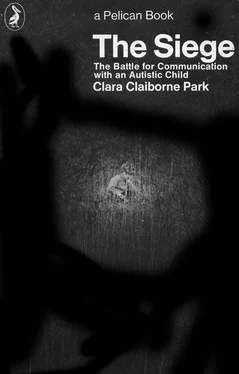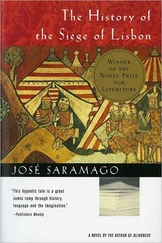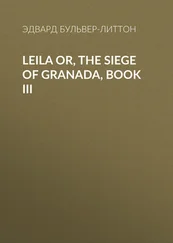But all this time it was I who was drawing, who was active, at work. Surely it would be better if Elly drew herself? That was very difficult to accomplish. Drawing meant pressure, meant holding pencil, crayon, brush, and Elly had no strength in her hands for that. I have told in Chapter i of the circles she crayoned when she was two and a half, and how she abandoned them. She abandoned crayons altogether — if one was successfully put into her fingers, the line she made was almost too faint to see. After those first miraculous circles and crosses there were no more drawings of any kind for almost a year, until Elly was a little over three.
An unusually active and imaginative baby-sitter had kept her while I was out, and instead of standing by while Elly did nothing, she had tried to engage her attention. I had told her that Elly recognized shapes, and Jill had taken paper and crayons and drawn her a sheet of triangles. She drew thirty of them before Elly herself made a faint, wavering, but unmistakable triangle. How did it happen? I was not there to see. But it was a doubly remarkable occurrence. Those circles and x’s of the past had been made, not in immediate imitation of a model someone had just drawn, but after a long delay. They appeared unexpectedly the next day or the next week, affording evidence, to the hopefully inclined, of intelligence, but also of that strange remoteness, the denial of interpersonal contact. The child would draw a circle, but it must not be an imitation of someone else’s circle; it must come out of nowhere. These frail triangles were different. They acknowledged not only hidden capabilities of eye and hand and brain, but a personal contact as well. The intensity and interest of this young girl had got through to Elly, who usually looked right through a stranger.
Perhaps she was reacting as normal children so often react — they are able to do for a stranger what they will not do for a parent, knowing it need not commit them. I acted as if that were the explanation, whether it was or not. I let it rest. Not until two days later did I get out paper and paint. Paint and brush might be harder to control than crayon, but Elly had no difficulty with control. The advantage of paint was that it required no pressure. Elly could be as weak as she liked and still make a mark.
This time Elly reproduced a triangle as soon as I made the model. (There are normal three-year-old children who cannot copy a triangle, but I did not know that then. ) During the next three months it was possible to get her to draw, at intervals. Always it was drawing; fastidious Elly never used paint as paint, never splashed, spread, or mixed it on the paper. She who could match colours spontaneously showed no interest in using them. Her drawings were monochrome — whatever colour she started with she stuck to. Magic marker came on the market that year and Elly soon preferred that, which requires no more pressure than paint and is easy to manipulate. For the weakness was still extremely prominent — it was about this time, after all, that I was working with her on flicking switches.
Elly drew rapidly and uninterruptedly, working for about twenty minutes at a time. (I noticed that, of course; attention- span is one sign of intelligence. ) She drew x’s, dots, lines, circles, triangles. She never scribbled at random, or even freely. Each line seemed weirdly deliberate, the product of a decision. I learned to take away one sheet as soon as she had drawn on it and substitute another; if I left a sheet in front of her, circles and triangles would disappear, carefully obliterated beneath a cloud of dots applied in close pointillism. Again, always, it was as if she did not want to commit herself — to assume the responsibility that admitting her new skill would imply.
Little of what Elly drew was spontaneous. They were copies of figures we had made. We made figures rather than pictures, since Elly at this time (about three and a quarter) had not yet recognized a picture. Seen without the significance we give them, letters are only figures. Somebody — I perhaps, perhaps one of the children — wrote Elly’s name in block capitals with the paints. The next time Elly drew, she made a rickety E. As of old, the act was delayed. She still retained her extraordinary ability to register impressions and bring them out, unpractised and unchanged, after an indefinite interval. About a week later she added an L — this three-year-old child who could neither speak nor comprehend.
It was very encouraging while it lasted. But by the time two and a half months had passed, with perhaps ten drawing sessions in that time, Elly’s interest was waning. It was harder to get her to draw herself, although I have a sheet of rectangles that she drew using my inert hand as a tool. Three months after her first triangles I made another set and tried to get her to draw some. She wouldn’t. When I tried the old trick of leaving one incomplete, the line she provided to finish it was more frail and wavering than the first ones had been. I took her hand and made it draw a pattern of cross-bars. This was new and interesting, and after two or three sheets of it her own will took over and she drew some of her own. The last two times she drew, it was she, not I, who decided on a drawing session; she astonished and delighted me by getting out marker and paper her-self. Then too, she put each sheet aside as she finished it, instead of going on to blot out the figures with marking. It was a fitting valedictory. Not for six months would she voluntarily take up brush, marker, crayon, or pencil. Once only, in that period, I got marks on paper out of Elly. I spent five minutes slowly painting bars and circles before she took my hand and, using it as her tool, made two parallel lines, an E, and two L’s. I gave her the brush. She made a final E alone and would make no more.
I let it go. It didn't seem worth it. There were other things we could do together, more than there had been — puzzles, pictures, even a little music. Accept the retreat which qualifies each advance. Hope that instead of denying the advance it somehow secures it. Put the paints and markers away — for a long time, this time, so that when they appear again they will seem interesting and quite new. But even so, when Elly, nearly four, did at length employ her hand to make a mark again, it was with neither paint nor marker, but in a totally new situation and one that bears thinking about. Taken to her father’s office, Elly used chalk and blackboard for the first time. She found it a uniquely satisfying medium. Anything she drew could be immediately erased, denied, cancelled, made as if it had never been.
Elly could deny her abilities to herself. But we knew now at least a little of what she could do. She could use her body and her hands. She could draw. More important, she could see — not only shapes and objects, but people, and not only these themselves but pictured representations of them. It was that much more than we had known two years before. We would have to be content with it.
Elly’s inabilities, physical and visual, were evident to us. But once she had learned to walk they were not conspicuous to others. Only those who observed carefully would notice the behind the apparent alertness, the passivity behind the deftness and apparent vigour. As Elly grew beyond two, to most people who knew her the significant thing was not that she did not push or reach or climb, not that she did not look at things, but that she did not talk. When a child reaches two and a half, and three, and four, mouthing no more than a few unintelligible syllables, it is this that tends to seem primary — especially if the child appears alert and attractive. It is natural to wonder if there has been some specific damage to the speech centres of the brain.
Читать дальше












